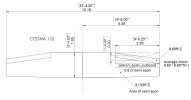- Messages
- 5
- Country
-

Hello,
i am confused about the definition of the htail_area and the elevator area.
In the ASOBO C152 flight_model.cfg i found this values:
[AIRPLANE_GEOMETRY]
wing_area = 160 ; Wing area S (SQUARE FEET)
htail_area = 15 ; Horizontal tail area (SQUARE FEET)
vtail_area = 14.22 ; Vertical tail area (SQUARE FEET)
elevator_area = 15 ; Elevator area (SQUARE FEET)
aileron_area = 20 ; Elevator area (SQUARE FEET)
rudder_area = 14 ; Elevator area (SQUARE FEET)
What is confusing for me is that the elevator area is the same as the htail_area.
same for the vtail and rudder area.
i would expect that the "elevator_area" is the control surface area, like the aileron for the wing.
i would expect that the "rudder_area" is the control surface area, like the aileron for the wing.
But for that the elevator_area and the rudder Area should be smaller. Like the aileron_area is smaller than the
wing area.
Maybe someone could help. is there a better documentation than the SDK-Docu out there?
best regards
Christoph
i am confused about the definition of the htail_area and the elevator area.
In the ASOBO C152 flight_model.cfg i found this values:
[AIRPLANE_GEOMETRY]
wing_area = 160 ; Wing area S (SQUARE FEET)
htail_area = 15 ; Horizontal tail area (SQUARE FEET)
vtail_area = 14.22 ; Vertical tail area (SQUARE FEET)
elevator_area = 15 ; Elevator area (SQUARE FEET)
aileron_area = 20 ; Elevator area (SQUARE FEET)
rudder_area = 14 ; Elevator area (SQUARE FEET)
What is confusing for me is that the elevator area is the same as the htail_area.
same for the vtail and rudder area.
i would expect that the "elevator_area" is the control surface area, like the aileron for the wing.
i would expect that the "rudder_area" is the control surface area, like the aileron for the wing.
But for that the elevator_area and the rudder Area should be smaller. Like the aileron_area is smaller than the
wing area.
Maybe someone could help. is there a better documentation than the SDK-Docu out there?
best regards
Christoph






